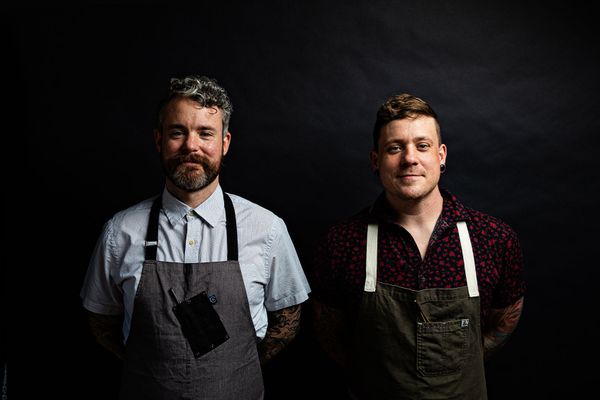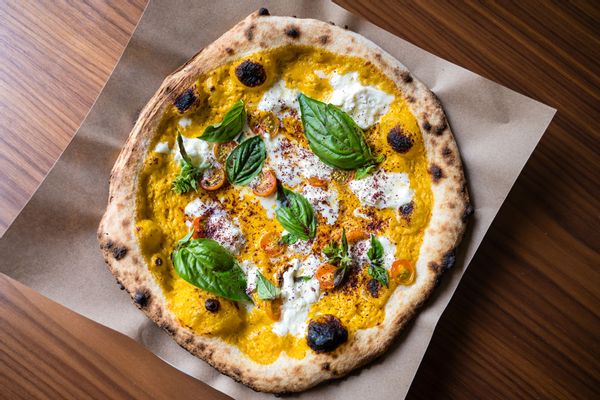
Since I was young, I've had a deep affinity for pepperoni rolls and bread. In recent years, I've given up pork, but that adoration for the pepperoni breads of my youth hasn't waned. I was especially partial to a local Italian stalwart called Vitamia which made the absolute best pepperoni bread imaginable (along with practically everything else on display in their storefront), as well as my cousin's pepperoni bread that she made every Christmas Eve, which I would eat with vigor.
Something I did not know, though, was that some trace the origins of pepperoni rolls to the Italian immigrants who lived in the Appalachain region, usually within North Carolina, Kentucky and West Virginia.
For some, it can often be inferred or assumed that the Northeast has a monopoly of sorts, if you will, on Italian-American identity, culture and cuisine. In actuality, though, that couldn't be further form the truth; the Appalachian region was the place that many Italians settled in when they immigrated to the U.S. hundreds of years ago.
Beyond the tri-state area, many Italian immigrants moved to the Appalachian region, primarily for mining jobs. (This was also exemplified in the horribly tragic event in which many of Italian immigrants lost their lives in a mine collapse; the Monogah coal mine explosion in 1907 killed over 300 miners — almost all migrant workers — nearly half of which were from Italy, many of which hailed from San Giovanni in Fiore, in Southern Italy.)
Many of those coal miners would often eat pepperoni rolls on their lunch breaks, which garnered the name "coal miner's lunch."
While Appalachian and Italian cultures may initially seem inherently distinct, there is much more of an overlap there than some might initially think. Italian immigrants left their mark on the region and now, years later, Luminosa in Asheville is honoring those who came before us, fusing Appalachian and Italian-American fare. The restaurant blends Appalachian ingredients and ingenuity with Italian-American grit and flavor profiles, harnessing an intrepid hybrid of culture and cuisine that is simultaneously inspiring and absolutely delicious.
A "hyperlocal" Italian restaurant in the Flat Iron Hotel — helmed by executive chef Graham House and Chef de Cuisine Sean McMullen — Luminosa seamlessly combines the two seemingly disparate categories into something holistic and cohesive.
Salon Food had the opportunity to to speak with House and McMullen to ask about the restaurant, Asheville and North Carolina on the whole, the menu, what originally got them into cooking and much more.
The following interview has been lightly edited for clarity and length. Questions 1-5 were answered by Executive Chef Graham House and questions 6-11 were answered by Chef de Cuisine Sean McMullen.

Hello! I love the line on the website that says "Modern-Appalachian Meets Italian Inspiration." Can you speak a bit to that?
GH: I've always referred to my style of cooking here in Asheville as "Modern Appalachian". Using only ingredients grown here with different modern techniques I've learned over the years in different regions and settings in my career. With I was hired to lead the kitchen at The Flat Iron Hotel, learning I'd get to work with a pizza oven, live fire grill and pasta extruder made it extra special for me. I was so excited to dig back into how Appalachian ingredients could be used in an Italian menu at Luminosa.
Can you tell me a bit about your come-up or 'pedigree' in the industry and what came before Luminosa for you?
GH: I was born and raised in Brevard, just outside of Asheville and I left the area in 2005 to dive into the culinary industry. I started in Atlanta, Georgia working in my first Italian restaurant in Buckhead, then had the opportunity to move just outside of Lake Como to work in a very old family osteria where my love for fresh pasta and pizza-making really took off.
After a short stint back in Atlanta, I moved out to Napa Valley, California where my obsession pivoted to vegetables and how to treat them as a main component of a dish and not just an afterthought. Taking my newfound love for produce and shopping local at farmers markets, I moved to San Francisco where the elite farmers markets aren't just for supplying restaurants but also a meeting place for local chefs to talk shop and bounce ideas off each other. This is where I really changed my style of food to a veggie-focused way of cooking.
At the end of 2016, I moved back to Asheville where my menus were very welcomed and I was able to reestablish close relationships with local farmers and makers of the area. I developed from the ground up a food program at a local cocktail bar and rooted myself in the dining scene of Asheville. In 2020 at the cusp of opening my own restaurant in town I, like many others, was forced to pivot. I dove into the art of whole animal butchery at The Chop Shop here in Asheville and was their culinary director building up a live fire catering program as well as a food truck in the River Arts District.
In March of 2023, I had the opportunity to put my hat in the ring for Executive Chef at the new Flat Iron Hotel with the Indigo Road Hospitality Group and the rest was history.
The menu is stunning. I'm so intrigued by the inclusion of a few ingredients: country ham, daylily shoots, Harueki turnips, blackberries in a pasta dish, cornbread crumb, garum caramel, etc. How do you normally approach menu development? Also, I must ask: What is a serviceberry? I'd never heard of it.
GH: Working with so many local farmers can be hard coordinating with their availability, delivery days, etc. Chef Sean and I have made a working detailed document outlining what each farmer has available every week. When you are only using local ingredients, it makes it really easy to change something when an ingredient goes out of season.
Sean and I stand in the walk-in cooler and look around and talk through dishes together. We are almost always both on the same page when it comes to playing around with flavors and textures and thinking outside of normal flavor combinations, while substituting ingredients that are local to us that serve the same purpose.
We also have a whole animal butchery program at Luminosa, which allows us to harvest very specific cuts from both cows and pigs and then get even more granular when offering unique dishes to our guests. Service Berries are a local perennial shrub that fruit only for a couple weeks in mid spring. They look like a blueberry, but kind of taste like a plum.

I am forever and always obsessed with chicken skin jus, so seeing a caramelized one on your menu made me very excited. How do you prepare it?
GH: Our chicken skin jus starts with a whole load of chicken skins in a hotel pan placed in our pizza oven for a really long time. We stir it constantly until the skins are deeply caramelized. We then deglaze with white wine and add mirepoix that’s been buried in hot embers to soak up all that smokey flavor.
Once the wine has cooked out, we add more aromatics and transfer the pan to a 350-degree oven to reduce to the thick and sticky jus that glazes the chicken on the plate. When the jus is cooled, we harvest the rendered chicken fat and infuse green herbs to make a green fat which we then drizzle over the chicken before it goes out to the guest.
Seems like North Carolina has become all the rage in recent years — what do you attribute that to?
GH: North Carolina is a very special place in regard to agriculture. Having access to both old growth mountains as well as unique shellfish habitats like the Outer Banks is a gift. It was only a matter of time before the right talent would move here and recognize all the bounty of our state. I love where I live and how versatile our region is in regard to variety of produce that can be grown here.
Why do you cook?
SM: I've always been passionate about cooking. It's a means of expression and a way to tell a story about your journey and the history that shaped that path. It's always been a way to connect with others and one way I can show people that I care for them. It's a field where you can constantly improve while striving for excellence. There's always more to learn and that makes it fun and exciting.

SM: Being in my grandmother's home with family with everyone gathered in or around the kitchen. It's the feeling of community and how food brings people together. This has always felt important to me.
What is your favorite cooking memory?
SM: I've made so many great memories cooking and traveling for food. I’ve met so many amazing people along the way. I'd have to say being a part of opening Luminosa with Graham is my favorite. It's been so much fun working with this amazing group of people. Getting to work with Graham to achieve this vision feels really special and important in this moment.

Do you have a number one favorite ingredient to cook with?
SM: I'd have to say the amazing produce from our farmers/friends that we get to work with every day. It's summertime, so the abundance of peak season produce is super fun and exciting. We're big on showcasing all of the outstanding fruits and vegetables that the nearby local farmers cultivate.
How do you practice sustainability in your cooking?
SM: Sustainability really starts by working with local ingredients while they are in season – this is something that is very near and dear to how Graham and I cook. Not just the vegetables but also the whole animals that make up a part of our menu. The agnolotti right now is filled with a farce made from the pork shanks we have from the weekly hog delivery. We take often neglected cuts of meat and find ways to showcase them on our menus.
We make all our stocks from the bones of those meat cuts every week. The beef tallow we produce is used in one of our Luminosa fryers during service. When it comes to vegetables, the whole thing can be used in one way or another. Fermentation is a big part of what excites me about sustainability. We pickle a lot of the veggies during the season and start vinegars with trimmings. We strive to have the least amount of waste possible.
What are some tips you'd give to home cooks for cutting down on food waste?
SM: One of the easiest tips is to use vegetable scraps to make stocks for cooking. Getting into fermentation also helps and fruit that looks less than perfect can be used to create some truly amazing vinegars. Composting is also huge for cutting down on food waste.







